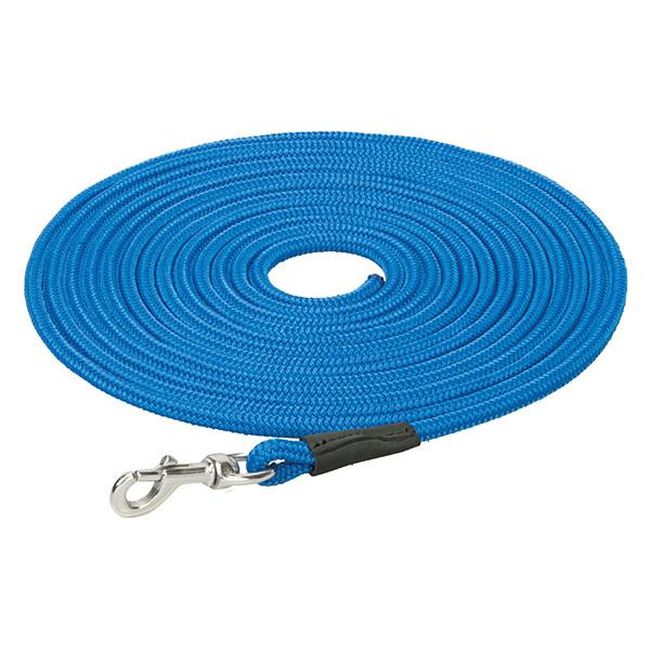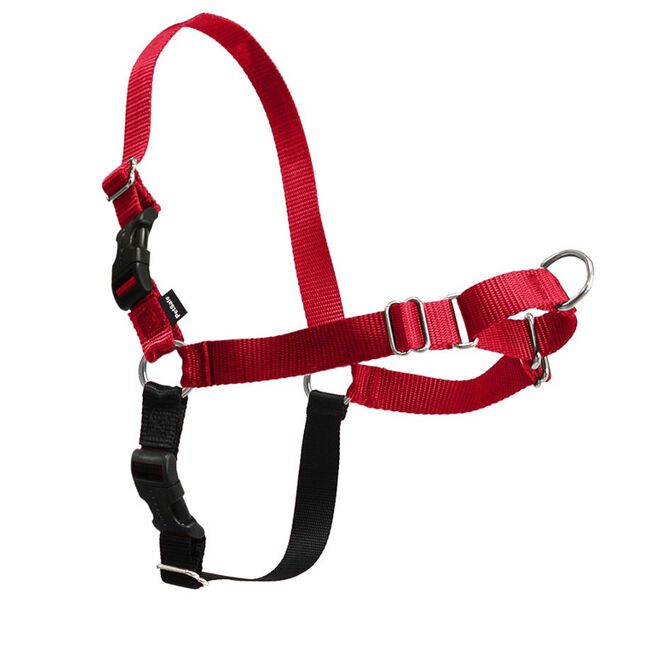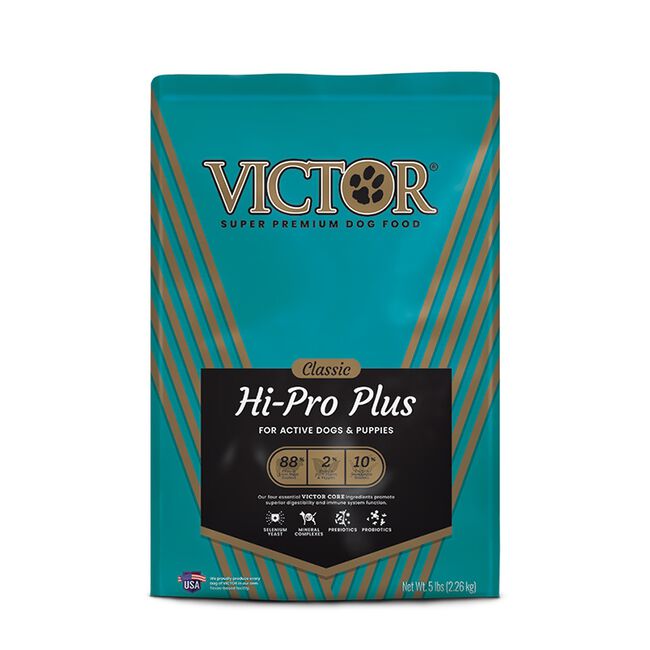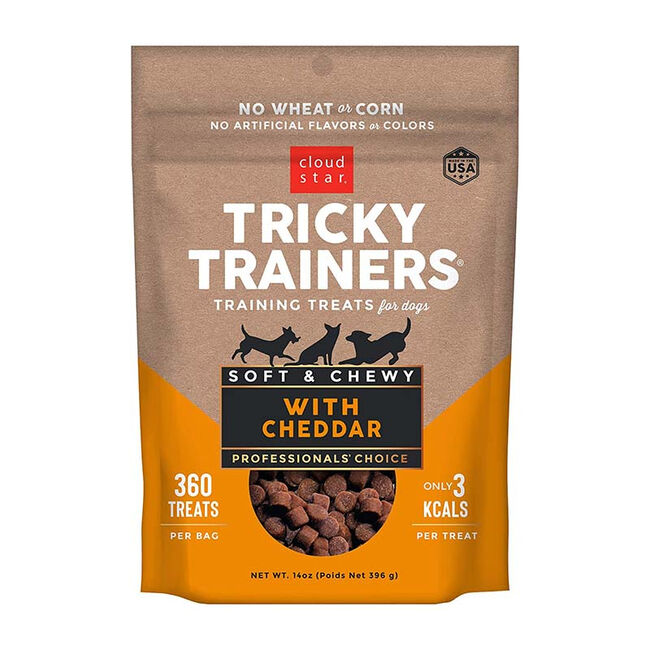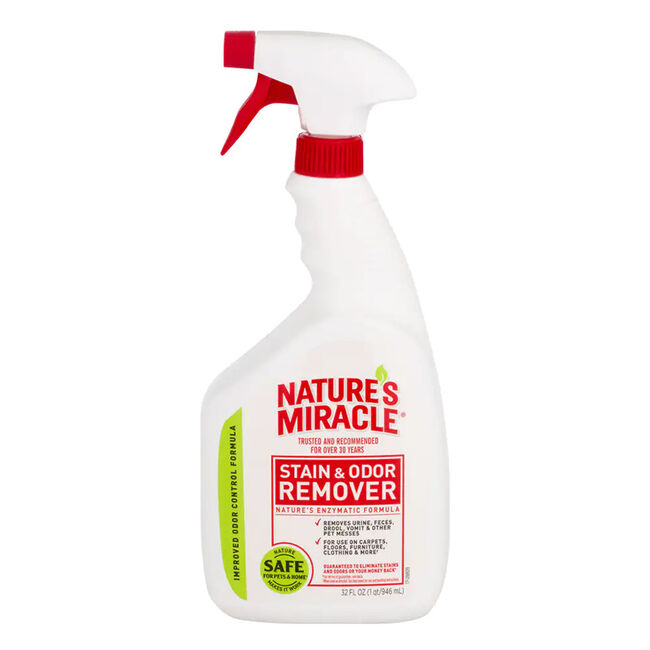
With their sweet face and adorable wiggles, adding a puppy to your family is such an exciting time in your life! A puppy brings their enthusiasm for life into your household and puts a smile on the face of everyone who comes in contact with them. However, in addition to the happiness that comes with owning a puppy, comes a lot of work and responsibility. The best way to ensure a successful transition for the puppy into your home is to be prepared and ready for the new addition. In this blog, we explore what needs to be done and what you should have on hand before picking up your new bundle of joy.
Questions to Ask Yourself
Bringing a new puppy into your home is a big decision. Before you begin looking for a new member of your family, we recommend asking yourself the following questions:
- Do I have the patience for a puppy versus a grown dog?
- Can I afford the puppy and the potential expenses?
- Am I allowed to add another dog to our housing situation?
- Will I be moving soon? Will my new location be able to accommodate my dog?
- Will the other animals in the home be welcoming to the puppy?
- Have I properly prepared my home?
- Do I have a plan for vacations or work-related trips?
- What does the breed of my choosing need in order to be happy and healthy? Have I properly researched the breed(s)?
- How much time do I have to dedicate to the training?
- What is the activity level of my family?
- Who will care for the puppy on a daily basis?
- What type of grooming will I be able to handle or support?
- Do I have a veterinarian selected?
Being Prepared

To ensure that you and your home are ready for the new addition, it is important to make certain that you have a plan in place for every situation. Determine if you and your family are ready to take on the responsibility of housebreaking, crate training, and obedience training, or will you be utilizing the services of an outside dog trainer. Even if you are comfortable with the process, it is a good idea to speak with your breeder or rescue about a dog trainer that they would recommend in case you end up deciding you might benefit from outside support. It is extremely important to understand how important the fundamental training foundation that you give your dog is. You can learn more on our blog post, The Importance of a Well-Trained Dog.
Think about the routines that you will have in place and how you may need to modify your schedules for at least the next 6 months. Will you be home during the day to let the puppy out? Perhaps you will need to bring the dog to a daycare situation? Making these arrangements prior to bringing your new puppy home will make the transition easier for everyone.
It is also important to speak with your veterinarian about your plans for a new puppy. He or she may encourage you to give your other animals booster shots in preparation for the new arrival. They also may help you set up your new puppy appointments, especially if they have a busy practice schedule and are already booking out a few months in advance. They will also give you a list of questions to ask the breeder or rescue, including whether or not the puppy has been wormed and which vaccinations they have received thus far.
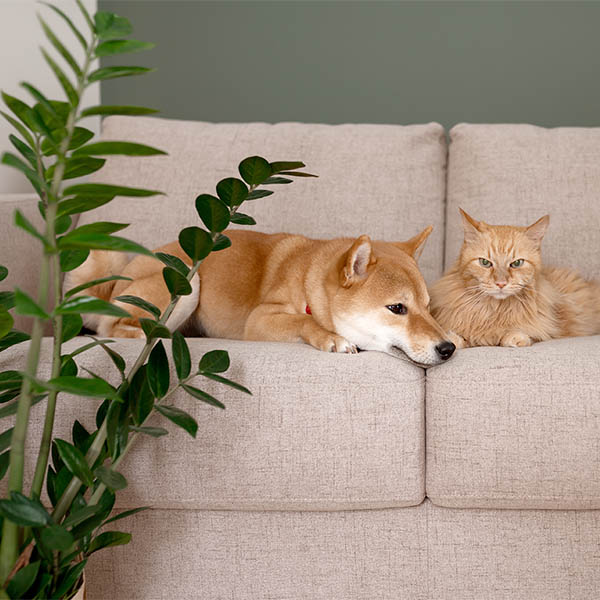
If this is the first dog or first puppy in a while that you are welcoming into your home, it is important to “puppy-proof” your home. Do a thorough walk through your home looking for potential dangers. Are there loose wires that a puppy could chew on? Are all of the household chemicals safely locked up? Puppies can (and will!) get into everything. You should do a careful inventory of your breakable objects that your puppy can access, wiggly puppies often lack body awareness and can accidentally knock into items that you might not think of as being dangerous, but present a hazard when broken (such as glass objects). Pick up items, like shoes, off the floor; if your puppy can access it, it is probable that they will nibble or chew on it. Additionally, take stock of your houseplants, many common plants can be poisonous if consumed. For more information, we encourage you to refer to our blog post, Navigating Indoor Plants With Pets.
The puppy proofing continues into your backyard! Look around for potentially hazardous things, such as poisonous plants, bird feeders, compost bins, and access to the road, then it is time to make a plan for your puppy while they are outside. Are you going to install a perimeter fence to keep your puppy safely enclosed? Are you going to utilize a harness and a tie-out situation to allow them to play outside? Perhaps you are going to use an electric fence or an electronic collar? It is important to consider how you envision your puppy utilizing the outdoor space that you have and ensuring that it is safe and ready for their arrival; most likely you and your puppy will spend countless hours here playing and learning together.
As a final measure, you need to make sure that everyone in the home has the proper education and training needed to successfully raise the puppy; this article from Modern Dog Magazine is a great resource, How To Read Your Dog’s Body Language. Children should be taught to give the puppy space and to never poke, hit, kick, or stand on them. Everyone in the household should be attuned to the dog’s body language – understanding what the animal is trying to communicate is very important. You should also review human foods that should never be fed to dogs. Foods that are poisonous to dogs include grapes, chocolate, onions, garlic, avocados, artificial sweeteners (particularly Xylitol), and alcohol.
With a bit of preparation and planning, welcoming the new puppy into your home will be an exciting venture. Your new four-legged friend will quickly become a member of your family with the proper training and guidance.
What to Have On Hand
Just like bringing an infant home from the hospital, a new puppy needs a lot of supplies! To make the first few nights in your home as stress-free as possible, we recommend having the following items on hand prior to your puppy’s arrival:
A Properly Fitting Collar
Each and every puppy needs a properly fitting, adjustable collar. Make sure that you feel the material of the collar to make sure it is soft and supple enough for your puppy’s sensitive neck. When adjusting a collar, you should be able to fit two fingers between the collar and your dog’s neck. A collar that is too loose will easily slip over your puppy’s head, they may also be able to get their paw or even their jaw stuck in the collar. Conversely, a collar that is too tight can cause choking, skin irritation, and muscle damage. When shopping for a collar, bring the measurement of your puppy’s neck with you, this will make it easy to select the proper size (if possible, ask the breeder or rescue because neck sizes can vary greatly). If you do not know the size, speak with a sales associate who has experience with puppies and age-appropriate collar sizing for assistance.
With puppies, it is important to consistently monitor the fit of their collar because they grow so quickly! It is a great idea to purchase an extra collar in a size larger than their first collar so that you will have one for them to grow into… you will need it before you know it.
For additional information on fitting a collar, check out this brief video:
Leash
A size-appropriate leash with a strong snap is an essential piece of equipment to hold control and contain your dog. Initially, your puppy will not know how to walk on the leash and it will be a tool to keep them close to you; with the proper training, they will begin to walk happily alongside you. Typically, you should aim to have a leash that is the same thickness as the collar. A leash that is too thin may break when your puppy pulls, while a leash that is too thick may place excess pressure on the neck of the puppy. Typically, a 6-foot long leash is the most common for daily use, but longer leashes, like the Weaver Terrain D.O.G. Training Cord, can be helpful when playing outside or for recall training.
Weaver Terrain D.O.G. Training Cord
A longer leash like this one can be great for controlling your puppy at a longer distance, especially while learning recall.
Training Tools
In addition to a standard collar and leash set, you will most likely need additional training harnesses and leashes. These products provide soft corrections to behaviors; with continued use, your dog will understand what you are asking of them. Harnesses are an important tool when training puppies to walk with you because they take the pressure off of the neck and allow you to control them with their chest and body. The PetSafe Easy Walk is an employee and customer favorite, discouraging dogs from pulling and helping them learn to walk nicely alongside you.
PetSafe Easy Walk Harness
When your dog pulls, this harness steers your dog to the side and redirects his attention toward you.
Identification
One of the most important, yet often overlooked, pieces of equipment that you will need is identification for your puppy. A dog tag with your name and phone number should be attached to your puppy’s collar as soon as you pick them up from the breeder or rescue. Puppies are often nervous and wiggly and can easily slip away from you. Having proper information about how to contact you if the puppy gets lost is the best way to ensure that your new companion will be returned to you quickly and safely.
In addition to a dog tag, microchipping is also an important form of canine identification. Communicate with the breeder or rescue prior to picking up the puppy, because many microchip the puppies while they are still small. Microchips are small computer chips that are quickly and easily placed just under your dog’s skin by your veterinarian. The chip is registered with your information so that if your dog is found, you can be contacted immediately.
A Safe Haven
While watching the puppy explore their new surroundings is such a pleasurable experience, sometimes puppies need places to decompress and feel safe and secure. These are also ideal places for your puppy and eventually older dogs to spend unsupervised time. Many dog owners choose to crate train their puppies, with durable wire crates, such as the Pet Lodge Double Door Wire Dog Crate, while others choose heavy-duty plastic crates, such as the PetMate Vari Kennel. This gives their dog a comfortable sanctuary and space to retreat to when they are feeling overwhelmed. If you use a wire crate, you may want to place a blanket or towel over the crate to make it feel more comfortable and “den-like.”
Pet Lodge Double Door Wire Dog Crate
This crate comes with a removable divider panel which lets you create a smaller space for your puppy, then allows the crate to expand as your pet grows to adult size.
Making sure that the crate is a safe and happy place for your puppy will make the crate training experience much more enjoyable for everyone. Consider purchasing a crate that is appropriate for the full-grown size of your dog, then you can use a divider while they’re small, then move it over as they grow, and eventually take it out completely. This means that you do not have to buy multiple crates throughout the dog’s life. For more information on crate training, we encourage you to read this blog post from the American Kennel Club, How to Crate Train Your Dog in Nine Easy Steps.
Wire exercise pens, like the Midwest 8 Panel Pet Exercise Pen, are also popular options that give the puppy owner great flexibility to contain the puppy in different ways. They can be used inside or outside easily and can be set up in a variety of ways. They allow the puppy to play together with other dogs, while also staying safely contained. Also consider utilizing pee pads, such as the Four Paws Wee Wee Pads, in a corner of the space to reinforce housebreaking and give the puppies a comfortable, encouraging area to relieve themselves. You can also use baby gates to keep your puppies confined to a specific area or out of rooms that you would rather not have them venture into.
Midwest 8 Panel Pet Exercise Pen
This convenient pen folds flat for storage and is easy to set up with no tools required.
Crates and containment areas are a wonderful way to prevent your puppy from overdoing it. While puppies are extremely playful and have seemingly endless amounts of energy, their muscles, joints, and bones are still developing and should not be overly stressed. Try to moderate their activity level to protect them from injury.
A Comfortable Bed
Active puppies also need their rest! A size-appropriate dog bed gives them a soft place to lay their heads at night. We recommend looking for dog beds with washable covers or covering the bed with a fleece blanket, such as the Ethical Pet Snuggler, which makes them easy to clean up after the inevitable accident. Many times the breeder or rescue will provide you with a towel that has familiar smells on it, this can be used on the puppy’s bed to ease the transition to their new home. While it may be tempting to purchase a bed for your puppy to grow into, the majority of puppies feel more comfortable and secure in an appropriately sized bed. A good rule of thumb is to purchase a bed that is 12” longer than your puppy, giving them room to stretch out. As you get to know your puppy’s individual personality and preferences, you purchase a style of bed that best fits their sleeping habits.
Comfort Toys
When your puppy first comes home, they may be very nervous and even feel lonely. This is especially common with puppies who have spent an extended period of time with their littermates or those who come from large litters. These puppies may become anxious in a new location and may feel uncomfortable in their new environment. To counteract this, many dog owners provide their puppy with a soft, plush toy. This plush toy can act as your young dog’s security blanket and give them some much-needed comfort during the first few days or weeks. You may even catch your new addition snuggling with it (please, look for stuffed animals without plastic eyes or noses, these may turn into choking hazards if your dog chews them off).
For additional comfort, you may want to consider playing soft, soothing music for your new dog. This may help them relax. Calming collars, such as the Thunderworks Thunderease Dog Calming Collar, can also help anxious puppies in their new environment.
Dog/Puppy Food
When you pick up your puppy from the breeder or the rescue, make sure that you get a small bag of the food that they are currently eating. Gradually change over their diets (if applicable), over the course of seven to 10 days to avoid digestive problems. Look for a high-quality puppy formula, like ORIJEN Puppy Dry Puppy Food or Fromm Gold Puppy Dry Dog Food, or all-stage dog food, such as Victor Hi-Pro Plus or Zignature Turkey Dry Dog Food, that will support your puppy’s protein, carbohydrate, vitamin, and mineral requirements. There are a wide range of dog foods available, including traditional kibble formulas, grain-free formulas, raw diets, freeze-dried food, and wet food… it can be overwhelming! Asking a veterinarian, trainer, pet nutritionist, pet supply sales associate, or breeder will be a big help in deciding which type of nutrition will best fit your puppy’s lifestyle.
Victor Hi-Pro Plus Dry Dog Food
This customer favorite dog food is suitable for dogs in all life stages.
When deciding what type of dog food to nourish your puppy, consider the future full-grown size of your pet and their level of exercise. Look for a formula that supports your individual puppy, such as a small dog or large dog formula. Your dog’s caloric needs will be changing constantly as they grow, so be sure to adjust their intake as needed, using the dog food bag and your puppy’s body condition as a guide. Many times puppies benefit from adding more meals throughout the day to accommodate their smaller stomachs while still reaching their caloric requirements. Typically puppies need three or four meals a day in the first few months and then can be transitioned down to fewer meals as needed.
As your puppy ages, at about 6 months old, they will reach their adolescent stage. Just like growing teenagers, they will continue to need more food to support their rapid growth. Puppy formulas and dog foods for all life stages are still appropriate for this age group to support their body condition as they mature. Make sure that you refer to the particular bag of dog food to read the feeding instructions and recommendations to understand how much food you should be feeding based on your dog’s age and weight.
A Water Dish
In addition to high-quality nutrition, puppies also need consistent access to fresh, clean water. As a general rule of thumb, puppies should drink at least one ounce of water per pound of bodyweight, each day. If you have an active puppy or a puppy with health issues, their water intake needs will increase.
When purchasing a water dish, look for a durable container that can withstand your puppy’s playful behavior. The Messy Mutts Stainless Steel Bowl and the YETI Boomer 4 Dog Bowl are both heavy-duty options that are popular for both puppies and adult dogs. Generally, stainless steel dishes are a popular choice because they are strong and do not harbor bacteria. Also, they will not double as chew toys! Place their feed dish and water bowl on a non-slip surface or mat, like the Messy Mutts Silicone Non-Slip Pet Bowl Mat, to keep the bowls in one place and discourage your puppy from playing with the bowls and pushing them all over the house.
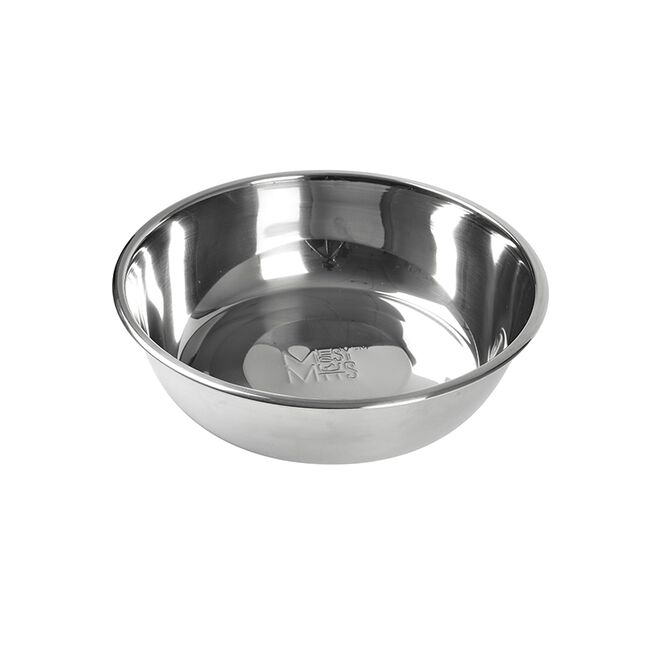
Messy Mutts Stainless Steel Bowl
These stainless steel bowls are non porous to minimize bacteria and fit in Messy Mutts feeders, and many other universal feeding systems.
While you are out and about with your puppy, they still need consistent access to fresh water. A travel bowl, such as the Kurgo Collaps A Bowl or the Kurgo Gourd Water Bottle & Bowl, is a great way to ensure that your pup is receiving the hydration that they need while you are on the go.
Chews and Chew Toys
During puppyhood and their adolescent phase, young dogs have an increased need for safe chews, particularly because they are teething and losing their baby teeth (milk teeth). As with any treat or toy, make sure that your puppy is closely monitored whenever you give them these products. The Virbac C.E.T. VeggieDent Tartar Control Chews for Dogs and the Benebone Bacon Flavored Puppy Pack Dog Chews are popular choices. Bully sticks and chew toys, like the Kong Puppy Dog Toy, the Nylabone Puppy Teething Keys, and the Nylabone Power Chew Double Action Chew Toy-Wolf, are great options that last longer for aggressive chewers and inquisitive puppies. For young dogs, many veterinarians and canine health professionals caution against rawhide chews, which may pose a choking hazard. Having an ample number of chews and chew toys around is a wonderful way to keep your puppy occupied.
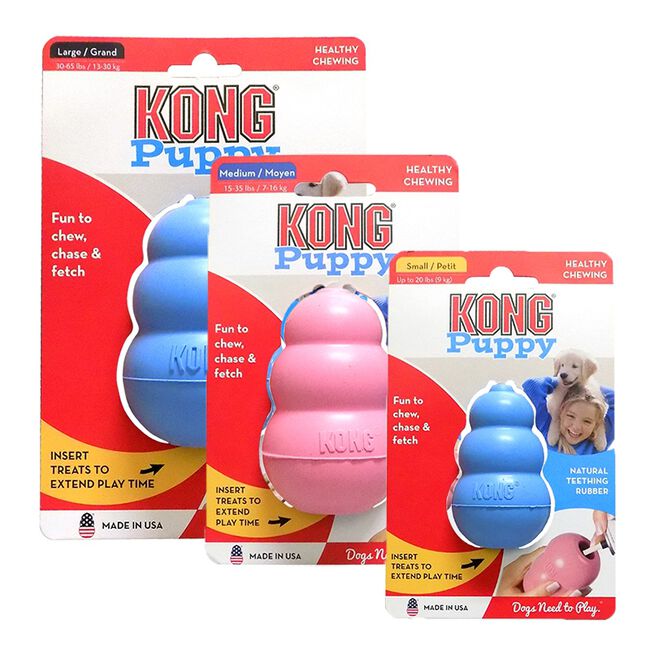
Kong Puppy Dog Toy
Designed to meet the needs of a puppy’s baby teeth, this toy helps teach appropriate chewing behavior while offering enrichment.
Safe Toys
Playful puppies love to run, jump, tumble, and play! Appeal to their sense of adventure and fun with a toy that you and your puppy can play with together. Choose a collection of tug toys, balls, interactive toys, and retrieval toys to see what your bundle of joy prefers. You may find that your puppy routinely plays with his or her plush toys, in this case, you may want durable stuffed toys, like the goDog Dragon Dog Toy or the goDog Dinosaur Spike Dog Toy. Puppies that chew a lot may remove the squeaker from plush toys, which is a choking hazard, please be sure to monitor them at all times with the toys. Other puppies, particularly those who are food motivated, love playing with treat-dispensing toys that distribute pieces of kibble as the puppy plays with the toy. The Starmark Treat Dispensing Chew Ball Dog Toy and the PetSafe Busy Buddy Treat Dispensing Kibble Nibble Dog Toy encourage your dog to nuzzle, push, and bat the toy around to receive a tasty treat.
Always choose large enough toys so that your dog cannot inadvertently swallow the toy and choke on it. Puppies should always be supervised whenever they have access to their toys.
Training Treats
Feeding tasty treats is a fun way to improve your relationship with your puppy. They are also wonderful rewards for your dog during a training session. When feeding your puppy treats, however, it is important to remember that they should be considered a part of your puppy’s daily intake and their diets may need to be adjusted accordingly.
Whenever possible, try to use smaller treats, like the Cloud Star Tricky Trainers Chewy Treats with Salmon, for training purposes, or break treats into smaller pieces so that they can easily eat them. Some puppies, particularly very food motivated dogs, even accept a piece of dog kibble as a reward for their behavior or a new trick. This is a good way to keep your dog at a healthy weight while also getting the benefits of training. When doing longer training sessions, consider reducing the amount of dog food that you feed that day because you are feeding extra calories in treats, including higher value treats. Additionally, vegetables, like carrots, can be a great treat and source of entertainment without adding too many extra calories.
Cloud Star Chewy Tricky Trainers
These small treats are only 2 kcals per treat! They’re ideal for dogs of all life-stages.
House Cleaning Supplies
Let’s face it, accidents are going to happen! Make sure that you have stocked up on your favorite house cleaning supplies prior to picking up your puppy. In addition to a plethora of paper towels (or reusable towels) and laundry detergent, we recommend an enzymatic surface cleaner, such as Nature’s Miracle Stain & Odor Remover. These natural products remove the stains and odors with enzymes to effectively remove all of the odor molecules. Not only does this eliminate the source of the odor, but it also discourages your dog from urinating there again (or “remarking”).
Nature’s Miracle Stain And Odor Remover
This essential cleaner contains an advanced enzyme technology that is guaranteed to permanently eliminate all stains and odors that other products fail to remove,
Grooming Products
Keeping your puppy clean is important for their skin and coat. You will want a quality dog shampoo, like the Durvet Naturals Puppy Shampoo, or a waterless shampoo product, such as the Nature’s Miracle Deodorizing Bath Wipes, to help clean your puppy as needed. Make sure that you purchase products that are appropriate for your puppy’s coat and care for it keeping their breed(s) in mind. A helpful reference is to refer to the American Kennel Club guide, How Often Should You Wash Your Dog. Grooming is also a wonderful way to bond with your dog, so make sure that it is an enjoyable time for everyone by using a calm and relaxed demeanor.
You will also want to monitor your puppy for signs of fleas and ticks, which they may have brought home from the breeder or rescue inadvertently. Speak with your veterinarian regarding flea and tick products that are appropriate for use on your young puppy.
Puppyhood Checklist
In summary, it is a good idea to have the following items on hand prior to picking up your new puppy:
- Collar
- Leash
- Harness
- Identification
- Kennel
- Exercise Pen
- Pee Pads
- Dog Bed
- Dog Bed Cover
- Comfort Toys and Tools
- Puppy Chow
- Food and Water Dish
- Portable Water Dish
- Food Dish Mat
- Poop Bags
- Chews
- Chew Toys
- Puppy Toys
- Training Treats
- House Cleaning Supplies
- Flea and Tick Control (if needed)
- Grooming Products
With proper preparation and planning, adding a young canine companion to your home can be one of the most joyous occasions. By ensuring that you and your household have everything in place to support your new puppy, you can be confident that the transition will be as stress-free as possible. Now… the fun part, enjoying those adorable puppy antics and soft puppy kisses!
At The Cheshire Horse, we have everything you need to welcome your new puppy into your home. If you have any questions regarding the products that you need for your puppy or would like assistance choosing the best puppy chow for your new bundle of joy, we invite you to speak with a member of our highly-trained, dog-loving sales staff.

